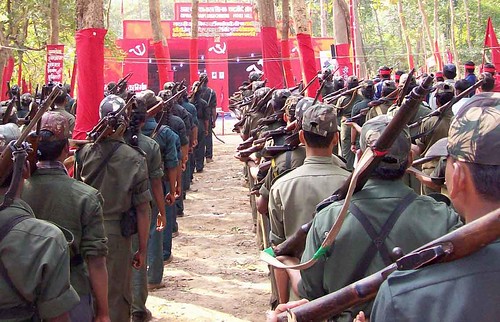
Fighters from the Communist Party of India (Maoists). The guerrilla units have killed over 70 police in early April 2010., a photo by Pan-African News Wire File Photos on Flickr.
Cannot rule out Maoists in Bodh Gaya strike, say officials
Mammen Matthew, Hindustan Times Patna, July 07, 2013
First Published: 22:05 IST(7/7/2013) | Last Updated: 22:07 IST(7/7/2013)
Even as the central agencies gun for the IM, police officials are not ruling out possible Maoist involvement in the Bodh Gaya temple complex serial blasts carried out on Sunday.
They base their observations on the fact, that IM or even the al Qaeda, have had no specific interests, engagements or fraternal relations with Kachin or Karen rebels in neighbouring Buddhist Myanmar, which could have rendered Bodh Gaya a target to send a message across.
Debriefings based on interrogations of IM operatives arrested from various parts of India, had indeed delivered an input of possible IM strikes in Bodh Gaya and other religious places in Bihar.
SP’s in Naxalite affected districts say, the Maoists had all the logical reasons to decide on such a strike, especially in Gaya-the hotbed of Red activity- to relieve themselves of the immense pressure now upon them due to concentrated police drives in Gaya-Jharkhand border areas and other parts of Bihar.
Their take merits a re-look for the spate of recent Naxalite strikes in Jamui, adjacent Jharkhand district of Dumka-Pakur, diversionary attack planned in Champaran and sporadic encounters in Gaya area, especially in Imamganj-Dumaria regions.
Only last week, the Gaya police and CoBRA batallions of the CRPF managed to establish a permanent camp at Dibra-Deo area, bordering Aurangabad in Jharkhand on the exit and ingress route of Naxalite squads, bottling several groups on either side to be targeted and weeded out.
Magadh Range DIG, Nayyar Hasnain Khan admitted that this would be an operational camp, where 600 jawans drawn from the district police and CRPF would permanently camp.
The forward base, designed specifically for area-domination exercises and aid forward policing without exposing long range patrols to risk of Red ambushes and mine blasts has taken away a major advantage of the Reds and brought the ‘war’ home to their own bases for the first time.
The permanent base has also obviated supply and stock replenishment lines, while baulking frontal and tactical strikes by Maoists on isolated pickets in the area.
The camp located in the deep jungle of Muhlang region and touching Red controlled villages of Seora, Barha, Subaicha, Tarachuan, Chakerbanda, Moharam, Kharhaon Tola, Islampur, Pichulia and Baltharwa in the Dumaria police station area, effectively prevents Maoist crossovers into Bihar and Jharkhand to escape police pressure and bottles their operational freedom. It also lays them open to well concentrated police strikes.
Commanders on the ground told HT, that Maoists managed to evade operations by sneaking into Aurangabad through villages in forested areas like Kachanpur, Bhaluahi, Bahadurdih, Jharna, Baklol Bigha etc.
With forward CRPF camps also coming up in inaccessible Lutua under Bankey Bazar police station, Sevra and Chakerbandha under Dumaria police station, the power of security forces to strike at will has unnerved the Reds.
SP”s say, “With supply lines snapping and movements restricted, a Bodh-Gaya like strike would have been a diversion”
Khan agreed, that CRPF forces have been thinned out as security concerns in neighbouring Bodhgaya mounts. “That”, top cops say, “would have relieved the Maoists from the security advance and allowed bottled Red squads to slip out. In that sense, the Bodhgaya attack could have been a diversionary one”.
They add: “The use of cyclinders with crude timers to set off Bodhgaya blasts is another Red signature as also the fact, that the bombs were placed at Temple Complex peripherals, indicating that a massacre was not intended.
The time picked at dawn would also indicate that the attack was designed for surprise maximum publicity besides to draw away the CRPF. In as much, the Reds, if they are involved, have succeeded.
The IM would have targeted the town closer to noon, when foreign nationals and domestic tourist traffic would have been highest, that too on a Sunday”.
No comments:
Post a Comment